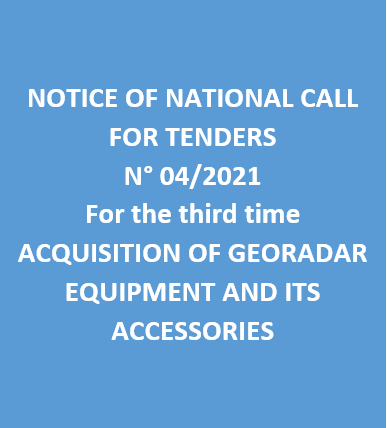| Annual program and technical progress report |
-

Activity Report 2023
-

Technical Program 2024
|
| Geocatalogue |

|
| Invitation to
tender |
-

REALIZATION OF THE TRAINING PLAN FOR THE YEAR 2022
-

ACQUISITION OF TWO SERVICE CARS
-

ACQUISITION OF GEORADAR EQUIPMENT AND ITS ACCESSORIES
|
|
Invest in Tunisia |

|
|
|
|
|
::
Documentation and Editions
>>
Research library
|
| |
|
[
Search by author
]
[
Search keyword
]
[
Search by index
]
[
Search by category
]
|
title of the reference :
|
The Cenomanian-Turonian boundary in the Gafsa-Chott area (southern part of central Tunisia)
|
|
Publication Date:
|
1997
|
|
Author :
|
Abdallah Hassen, Meister Christian
|
|
Catalogue type :
|
Livre
|
|
Catalogue reference :
|
T.18 (GBR) Cretac. res. T.18 The Cenomanian-Turonian boundary in the Gafsa-Chott area (southern part of central Tunisia) biostratigraphy, palaeonvironments. This study based on biostratigraphical and palaeonvironmental analyses of four colummar sections exposed in the Gafs-Chott area of central TUnisie. The Cenomanian-Turonian deposits in this area are divisible into Zebbag s.s. (at base), Bahloul and Gattar Formations or their equivalents. The Cenomanian-Turonian boundary is placed within the Bahloul Formation s.s. on the basis of the occurrence of several index ammonite faunas including Choffaticeras aff. massipianum (Pervinquière). The Gattar Formation and its equivalents are assigned to a part of the late Early Turonien (Thomasites rollandi and Choffaticeras luciae Intervals). The occurrence of Spathites (Jeanrogiceras)aff. revelieranus (courtiller)encrusting the top of Gattar equivalent probably indicates the top of the Lower Turonien. The meaning of the association C. luciae Pervinquière, Thomasites rillandi forma jordani Pervinquière and S. (J.)aff. revelieranus with respect to the M. nodosoides Zone needs to be clarified. A wide lateral variation in facies in the characteristic feature of the sequence, caused by a rapid change in the depositional setting.It has been concluded that the Cenomanian-Turonian transition of the area under consideration was deposited in a dysaerobic environment, as evidenced by the occurence in a basin setting of a micritic limestone unit rich in organic matter with planktonic and nektonic organisms and certain stunted neritic fossils. Oxygen improverishement was less drastic on the carbonate platforms, as indicated by the occurence of pelagic white limestones devoid of organic matter and containing cephalopods as weli as planktonic foraminifers and minure bivalves. bibliogr. paléoenvironnement ; ammonitina ; biostratigraphie ; cenomanien ; turonien ; Tunisie ; Tunisie Sud Occidentale ; Gafsa Meister Christian Abdallah Hassen Roches Sédmentaires, Sédimentologie
|
|
Indexation decimale :
|
Roches Sédmentaires, Sédimentologie
|
|
Keywords :
|
paléoenvironnement ; ammonitina ; biostratigraphie ; cenomanien ; turonien ; Tunisie ; Tunisie Sud Occidentale ; Gafsa
|
|
Summary :
|
This study based on biostratigraphical and palaeonvironmental analyses of four colummar sections exposed in the Gafs-Chott area of central TUnisie. The Cenomanian-Turonian deposits in this area are divisible into Zebbag s.s. (at base), Bahloul and Gattar Formations or their equivalents. The Cenomanian-Turonian boundary is placed within the Bahloul Formation s.s. on the basis of the occurrence of several index ammonite faunas including Choffaticeras aff. massipianum (Pervinquière). The Gattar Formation and its equivalents are assigned to a part of the late Early Turonien (Thomasites rollandi and Choffaticeras luciae Intervals). The occurrence of Spathites (Jeanrogiceras)aff. revelieranus (courtiller)encrusting the top of Gattar equivalent probably indicates the top of the Lower Turonien. The meaning of the association C. luciae Pervinquière, Thomasites rillandi forma jordani Pervinquière and S. (J.)aff. revelieranus with respect to the M. nodosoides Zone needs to be clarified. A wide lateral variation in facies in the characteristic feature of the sequence, caused by a rapid change in the depositional setting.It has been concluded that the Cenomanian-Turonian transition of the area under consideration was deposited in a dysaerobic environment, as evidenced by the occurence in a basin setting of a micritic limestone unit rich in organic matter with planktonic and nektonic organisms and certain stunted neritic fossils. Oxygen improverishement was less drastic on the carbonate platforms, as indicated by the occurence of pelagic white limestones devoid of organic matter and containing cephalopods as weli as planktonic foraminifers and minure bivalves.
|
|
Exemplaries :
|
TU2010
|
|
|
|
|
|
|
|



